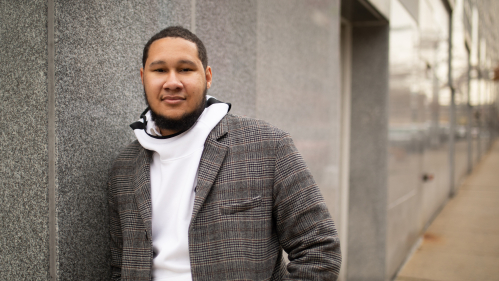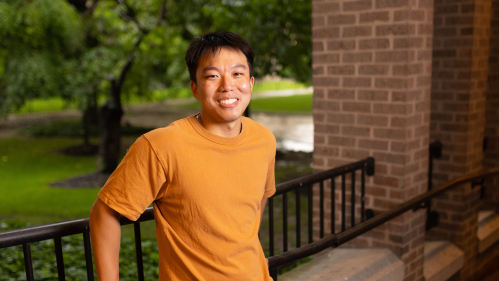Rutgers Campaign for Student Aid Passes $10 Million Mark

President Jonathan Holloway called for broad support for Rutgers’ Scarlet Promise Grants on his first day
Helping close financial gaps for thousands of Rutgers students, the university’s alumni and friends contributed more than $10 million in one year to support the Scarlet Promise Grants, President Jonathan Holloway announced.
On his first day as president on July 1, 2020, Holloway called on the Rutgers community to support the grants, which provide need-based financial aid and emergency support to more than 9,000 Rutgers students annually. He pledged university funds and a personal donation to kick-start the campaign that surpassed its goal during the past fiscal year, which ended June 30.
“There is no greater calling for university communities today than to make sure our students can pursue an excellent, life-changing education regardless of economic challenges,” Holloway said in launching the campaign last year. “Every dollar contributed to the Scarlet Promise Grants is a declaration for the transformative power of a Rutgers education.”
Receiving a Scarlet Promise Grant allowed Israel Alford, a student in the Rutgers-Newark School of Public Affairs and Administration, to register for classes without taking out a loan.
“The grant covered the balance that financial aid didn’t cover,” said Alford, adding that he was able to focus on growing as a social justice advocate, a community member and a civic leader.
Students who have received the grants say the financial help puts college in reach for people who might not feel it’s possible and transforms their experience at Rutgers.
“My grant took a lot of pressure off of me,’’ said David Zhu, a student in the School of Arts and Sciences at Rutgers University-New Brunswick. “With it I could focus on school and not have to work all the time. Now I feel comfortable thinking about what I can do with my life, even with everything that’s been happening.”
Last year, 9,189 Rutgers students received Scarlet Promise Grants, including $17.2 million in need-based financial aid and $12 million in short-term emergency financial assistance. Since President Holloway issued his July 1, 2020, call for support, more than 3,558 donors have contributed to the Scarlet Promise Grants with gifts ranging from $5 to $1 million.
“Our donors never have had such an immediate impact on the lives of our students,” said Lavinia Boxill, interim president of Rutgers University Foundation. “Their gifts provide the means for thousands of students to attend Rutgers and to continue their studies when difficulties arise. This year, there was new urgency, and the Rutgers community really came through.”

Rutgers has one of the highest percentages of students with significant financial need among its Big Ten and Association of American Universities peers. Nearly one third of Rutgers-New Brunswick students receive Pell Grants, and almost two-thirds receive need-based financial aid each year. At Rutgers University-Camden, 51 percent of students receive Pell Grants, and at Rutgers University-Newark, 58 percent of students receive Pell Grants.
The average unmet need – the amount left to pay after financial aid is awarded – among Rutgers students receiving financial aid is more than $11,000 each year, according to a Rutgers Task Force on Student Aid report.
The Scarlet Promise Grants make a difference for Inaya Thompson, a biology/pre-medicine major at Rutgers-New Brunswick’s School of Arts and Sciences. She hopes to enter medical school after graduating in 2023 and eventually become a doctor of naturopathic medicine.
“Knowing that I have a community that is by my side to provide me with assistance financially and morally allows me to continue to push and set a high standard of academic achievement,” said Thompson.
The Scarlet Promise Grants took on new significance in 2020 and 2021, helping many to attend and continue at Rutgers in the face of the global pandemic and its economic consequences.
The pandemic exacerbated economic disparities. According to the National Center for Education Statistics, in August 2020, 31 percent of adults 18 years old and over who had household members planning to take classes in fall 2020 at a postsecondary institution reported that all plans to take classes in the fall had been canceled for at least one household member. And 42 percent cited not being able to pay for classes and educational expenses due to pandemic-related changes in income.
“This is a victory for our students and for Rutgers,” Holloway said. “Empowering great students from every point on the economic spectrum to attend a school like ours is a hallmark of excellence in higher education. And this is a victory for the Rutgers community – a wonderful display of unity, principle and character.”
Susan Badia, a student at Rutgers Business School-Newark and New Brunswick, said the grant opened doors she didn’t think were possible.
“These grants help students like me who want to go far,’’ Badia said. “Soon, I am going to be on Wall Street with my degree which, in a way, is pretty intimidating. But I know that the future is bright and I’m going to give it my all.’’


